You are here
Geoscience Class: Shipworms
Introduction to Shipworms
k’yúu ts’udalaas aa (ts’ujuus aa)
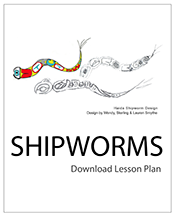
What You Will Learn
- What is a Shipworm?
- Where do Shipworms Live?
- Shipworm Anatomy
- Shipworm-Bacterial
- Symbiosis
- Importance of Shipworms
- How to Collect Shipworms
- Haida Terms for Shipworm Study
DOWNLOAD LESSON PLAN ON SHIPWORMS→
Classroom Highlights
Students taking part in the Geoscience Education Program present their research at national conferences. For many students this is their first opportunity to attend a conference/scientific meeting, take part in presenting research publicly or traveling outside of Alaska.
Conference: AISES National Conference 2010, Albuquerque N.M.
Student Poster: "Depth As An Independent Variable Affecting Shipworm Colonization"
Authors: Marqeutte Patterson, Katherine Kadake, Marina Jones, Silas Faucet, Ashley Christenson, Kimalya DelGuzman, Nick Nix, Thomas Dilts, Taan Morrison, Curtis Cline, Matthew Richardson, Meghan Betcher, Benjamin Young, Richard Hugo, Wendy F. Smythe, Margo Haygood, Antonio Baptista, Hydaburg High School, Hydaburg Alaska, OHSU Institute of Environmental Health, Portland State University Department of Geology, Center for Coastal Margin Observation & Prediction
Abstract: Shipworms are not worms but rather wood boring marine bivalve mollusks that are related to soft shell clams. These animals bore into wood for shelter and nutrients, using their small-modified shell, which is adapted for the specialized function of grinding wood. There are very few organisms capable of utilizing wood as a their primary food source, due to the difficulty of digesting cellulose, even so, wood boring bivalves are found in all oceans, and are widely distributed in shallow waters in tropical and temperate regions. Shipworms are tolerant to changes in temperature, salinity, and oxygen availability. The presence of shipworms in an environment is dependent on many environmental variables that can be tested and observed, in this study, depth was chosen as an independent variable. Shipworm traps were constructed using red cedar, due to its abundance in the region; traps were deployed at various depths and examined periodically for evidence of shipworm colonization. Data from this study suggests that depth may be an important factor in the colonization of shipworms as traps below 10 meters were preferentially colonized, while traps higher in the water column showed no evidence of colonization.
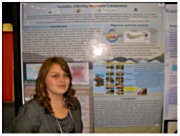 Marquette Patterson (Haida)
Marquette Patterson (Haida)
Senior, Hydaburg High School
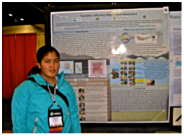 Katherine Kadake (Haida)
Katherine Kadake (Haida)
Junior, Hydaburg High School
Geoscience Alliance Meeting 2012, Pablo, MT.
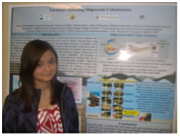 Lauren Smythe (Haida/Hawaiian)
Lauren Smythe (Haida/Hawaiian)
Eighth Grade, South Meadows Middle School
Group Members
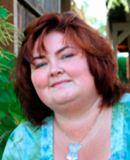 Wendy F. Smythe is a Ph.D. student in the laboratory of Dr. Bradley Tebo at Oregon Health & Science University (OHSU) in the Institute of Environmental Health. She studies manganese oxidizing microorganisms from various environments, with particular interest in microbe-mineral interactions and biogeochemical cycling. Wendy is Haida from Hydaburg, Alaska located on Prince of Wales Island in Southeast Alaska.
Wendy F. Smythe is a Ph.D. student in the laboratory of Dr. Bradley Tebo at Oregon Health & Science University (OHSU) in the Institute of Environmental Health. She studies manganese oxidizing microorganisms from various environments, with particular interest in microbe-mineral interactions and biogeochemical cycling. Wendy is Haida from Hydaburg, Alaska located on Prince of Wales Island in Southeast Alaska.
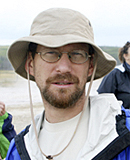 Rick Hugo is a Senior Research Associate in the Department of Geology at Portland State University. Rick's research projects utilize electron microscopes in geoscience research. He also engages in many science education and outreach projects in under served communities.<
Rick Hugo is a Senior Research Associate in the Department of Geology at Portland State University. Rick's research projects utilize electron microscopes in geoscience research. He also engages in many science education and outreach projects in under served communities.<
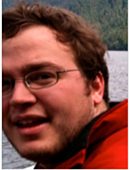 Sean McAllister was born and raised in Eagle River, Alaska, and spent much of his youth backpacking and camping around southwest, south-central, and southeast Alaska. Sean is currently a research assistant at Western Washington University, where he graduated with his Master of Science degree in marine microbial ecology. Sean is interested in marine and extremophilic microbial environments and processes, and in educating the next generation about these spectacularly diverse, intricately connected, and human-impacted ecosystems.
Sean McAllister was born and raised in Eagle River, Alaska, and spent much of his youth backpacking and camping around southwest, south-central, and southeast Alaska. Sean is currently a research assistant at Western Washington University, where he graduated with his Master of Science degree in marine microbial ecology. Sean is interested in marine and extremophilic microbial environments and processes, and in educating the next generation about these spectacularly diverse, intricately connected, and human-impacted ecosystems.
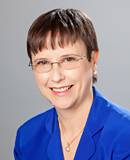 Dr. Margo Haygood: Dr. Haygood's research group has two main areas of interest - bioactive metabolite symbiosis and iron acquisition by marine microbes. These areas may not seem related, at first, but both revolve around the amazing versatility of microbes as chemists, and their often-unrecognized ecological impact on marine environments. Dr. Haygood is also a PI for the Philippine Mollusk Symbiont- International Conservation Biodiversity Group, which targets useful natural products from marine mollusks. Visit the Haygood Lab website
Dr. Margo Haygood: Dr. Haygood's research group has two main areas of interest - bioactive metabolite symbiosis and iron acquisition by marine microbes. These areas may not seem related, at first, but both revolve around the amazing versatility of microbes as chemists, and their often-unrecognized ecological impact on marine environments. Dr. Haygood is also a PI for the Philippine Mollusk Symbiont- International Conservation Biodiversity Group, which targets useful natural products from marine mollusks. Visit the Haygood Lab website
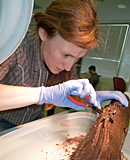 Meghan Betcher is a Master of Science student in the laboratory of Dr. Margo Haygood at OHSU's Division of Environmental and Biomolecular Systems. She studies the biology of the wood boring marine bivalve mollusk, the shipworm, and its bacterial symbionts. Specific goals of her work include isolation and characterization of previously uncultivated shipworm symbionts and in-situ localization of shipworm-associated bacteria. Meghans research is a part of the Philippine Mollusk Symbiont- International Conservation Biodiversity Group.
Meghan Betcher is a Master of Science student in the laboratory of Dr. Margo Haygood at OHSU's Division of Environmental and Biomolecular Systems. She studies the biology of the wood boring marine bivalve mollusk, the shipworm, and its bacterial symbionts. Specific goals of her work include isolation and characterization of previously uncultivated shipworm symbionts and in-situ localization of shipworm-associated bacteria. Meghans research is a part of the Philippine Mollusk Symbiont- International Conservation Biodiversity Group.










